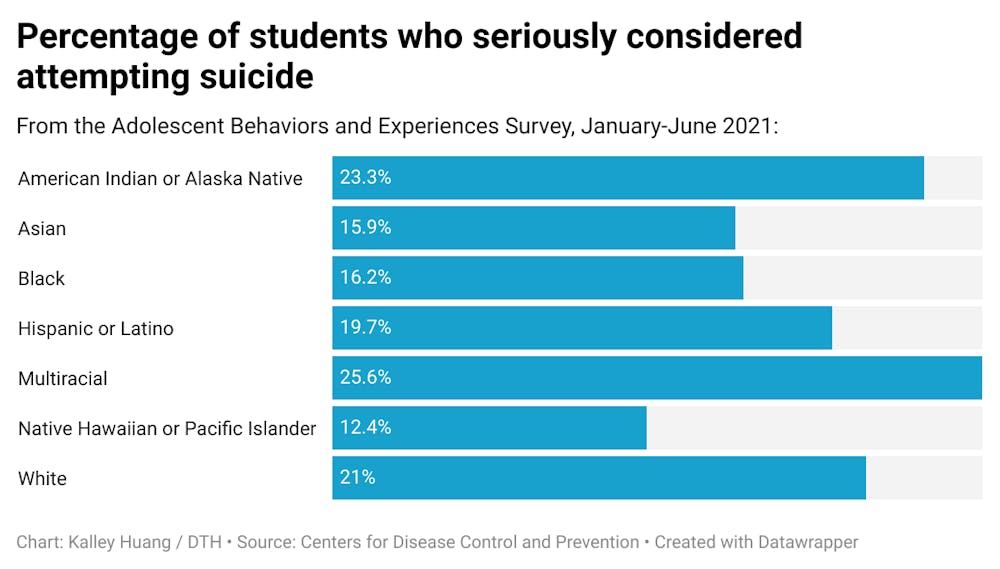N’Zai Davis, a junior at East Chapel Hill High School who identifies as a bisexual and nonbinary African American, said the longevity of the pandemic worsened their mental health.
Davis, who was a freshman at the start of the pandemic, is now a junior. And as the pandemic went on, Davis said they felt increasingly disconnected from their friends.
“I was coming to terms with some things in my own personal life, so it was a great time for change as well as a hard time to get through because it felt like a lot of people were disconnected and it felt lonely,” they said. “It honestly just felt very lonely.”
'A cry for help'
Lee’s and Davis’ experiences are not unique. The pandemic, and the isolation that came with it, drastically affected mental health among students.
“I know a lot of people that the pandemic was much harder than for me,” Davis said. “Some people were on the verge of doing things to themselves or to others that they can’t take back, and that's horrible. I don't wish that upon anybody.”
The CDC survey showed that 37.1 percent of high school students experienced poor mental health during the COVID-19 pandemic.
Furthermore, 19.9 percent of students had seriously considered attempting suicide, and 9 percent had attempted suicide.
“These data echo a cry for help,” CDC Acting Principal Deputy Director Debra Houry said in a March 31 press release. “The COVID-19 pandemic has created traumatic stressors that have the potential to further erode students’ mental wellbeing.”
To get the day's news and headlines in your inbox each morning, sign up for our email newsletters.
Minority communities were more at risk of facing mental health issues, according to the data presented in the survey.
High school students who identified as gay, lesbian and bisexual also had the highest rates of suicidal thoughts and behaviors.
Specifically, about one in four high school students who identify as gay, lesbian or bisexual attempted suicide during the COVID-19 pandemic, according to the survey.
Nadia Charguia, an associate professor and child psychiatrist with the UNC Department of Psychiatry, said she has seen increased rates of suicide and suicidal thoughts, depression, anxiety and hospitalizations among adolescents.
These trends are even more apparent among members of minority populations, she said.
“These groups of individuals and our adolescent community as a whole may not have the same access to support or resources, may be on the receiving end of a bias, are at more risk of violence due to being in a minority group,” Charguia said.
According to the CDC press release, adolescent experiences with racism have been linked to poor mental health.
Multiracial students had higher percentages of suicidal thoughts than Black and Asian American students. Among multiracial students, 25.6 percent reported having seriously considered attempting suicide, and 12.3 percent attempted suicide.
The survey also found that American Indian or Alaska Native students had the highest rates of attempted suicide compared to their peers of other ethnicities and racial backgrounds, at 20.1 percent.
Lee said they saw an increase in violence against Asian Americans during the pandemic. From March 19, 2020, to December 31, 2021, the coalition Stop AAPI Hate reported 10,905 hate incidents against Asian American and Pacific Islander people.
They said this violence has made them hyperaware about their own safety and place in society.
“All over social media, graphic videos with people who like look like me getting attacked on the streets just because we look the way we do,” they said.
Davis added that racial injustices during the pandemic affected them, noting that the 2021 United States Capitol attack harmed their mental health.
“Those events almost felt like I was in third person viewing it because of the pandemic, because it felt like there wasn't anything I can do,” they said. “That's one thing that, at least on the side of being an African American person, it just hurt. It did not feel great.”
Addressing the crisis
As schools return to pre-pandemic policies, students are beginning to reconnect with others.
Data shows that students who felt close to others had a lower prevalence of poor mental health during the pandemic.
According to the survey, 28.4 percent of students who felt connected to others at school had poor mental health, while 45.2 percent of students who did not feel connected reported poor mental health.
Charguia said connection is an important step in addressing and overcoming mental health issues that were worsened by the pandemic.
She said feeling connected and supported by a community is an important protective factor for high school students.
Kathleen A. Ethier, director of the CDC’s Division of Adolescent and School Health, echoed this thought, emphasizing connection in schools in the March 31 press release.
“Students need our support now more than ever, whether by making sure that their schools are inclusive and safe or by providing opportunities to engage in their communities and be mentored by supportive adults,” Ethier wrote.
@emmymrtin | @DTHCityState
city@dailytarheel.com | elevate@dailytarheel.com
Emmy MartinEmmy Martin is the 2023-24 editor-in-chief of The Daily Tar Heel. She has previously served as the DTH's city & state editor and summer managing editor. Emmy is a junior pursuing a double major in journalism and media and information science.





